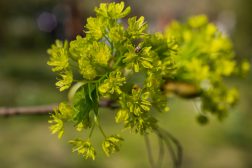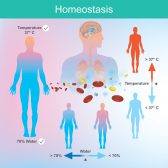Definition
noun, plural: glycerides
(biochemistry) Any of the esters formed from glycerol reacting with fatty acids, and function primarily as fat storage molecules
Supplement
Glycerides are esters formed from glycerol reacting with fatty acids. Their primary function is to serve as fat storage molecules. They may be classified based on the number of fatty acids reacting with glycerol. The fatty acids can react with one, two, or all three of the hydroxyl functional groups of the glycerol to form monoglycerides, diglycerides, or triglycerides, respectively.
A monoglyceride is a chemical compound comprised of a glycerol and an acyl moiety. Two major types are 1-monoacylglycerol and 2-monoacylglycerol. 1-monoglycerol is a type of monoglyceride wherein the fatty acid is attached to a primary alcohol. 2-monoacyglycerol is one in which the fatty acid is attached to the secondary alcohol. Monoglycerides primarily serve as an intermediate in the degradation and synthesis of lipids. Hydrolysis of monoacylglyceride results in the production of a fatty acid anion and a glycerol by the catalytic action of the enzyme, monoacylglycerol lipase.
A diglyceride is an ester from glycerol with two fatty acid molecules joined through ester linkages. In humans, the dietary source of diglycerides is food containing triglycerides. The triglyceride is digested and broken down into monoacylglycerol (monoglyceride), diacylglycerol (diglyceride), or free fatty acids. Diglycerides may be converted into triglycerides by the addition of a third fatty acid through the catalytic action of diglyceride acyltransferase. Diglycerides are essential for their biological role: as a signaling lipid molecule, Munc13 Activation, a source for prostaglandins, a precursor of 2-arachidonoylglycerol (an endocannabinoid), and an activator of TRPC3/6/7 (a subfamily of transient receptor potential canonical cation channels).
A triglyceride consists of a glycerol and three fatty acids wherein the three hydroxyl groups of glycerol in triglyceride are all esterified. The triglyceride is a major component of animal and plant oils and fats. In plants, they are a minor component in plant cell membrane and the fatty acids are mostly unsaturated. In animals, the fatty acid component is largely saturated. Triglycerides are sometimes referred to as “fat” to pertain to a triglyceride that is usually solid at room temperature. Conversely, a triglyceride that is liquid at room temperature is referred to as “oil“.
See also:
Dictionary > Glyceride
You will also like...

Muscle
Muscle cells are specialized to generate force and movement. Learn about the different types of muscle tissues in this t..

Darwin and Natural Selection
This tutorial investigates the genetic diversity in more detail. It also delineates how certain alleles are favored over..

Community Patterns
Learn about community patterns and the ecological factors influencing these patterns. Revisit some of the ecosystems you..

Cell Structure
A typical eukaryotic cell is comprised of cytoplasm with different organelles, such as nucleus, endoplasmic reticulum, G..

Gibberellins and Gibberellic Acid
This tutorial describes the role of gibberellin family in plants. Find out the effects of gibberellin on plant growth an..

Physiological Homeostasis
Homeostasis is essential to maintain conditions within the tolerable limits. Otherwise, the body will fail to function p..

